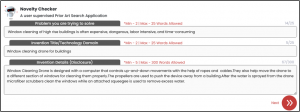
The invention described in your application must be novel, non-obvious, and useful in order to be granted a patent. The novelty requirement in 35 U.S.C. 102 simply means that your idea is unique and has never been disclosed publicly. There is no prior art that describes your invention, including patents and non-patent literature. As explained in your patent application, your technology has never been offered for sale. If published, your invention as outlined in your patent application would not infringe on an existing patent. Although, there is an exception to the patent novelty requirement in the United States. The invention is still novel if the inventor discloses a technology and files for a patent on that technology within the year-long grace period.
Conducting a Novelty Search
A patent novelty search examines prior art that is conceptually and semantically similar to your invention to determine whether or not it is novel. Classification codes can also be used to identify relevant patents during a novelty search.
Any patent search necessitates resources. Limiting the amount of money and time you spend on patent novelty search can be tempting. However, you must examine the consequences of inventing and filing without first researching similar prior art. XLSCOUT suggests conducting a novelty search several times throughout the innovation lifecycle, such as during ideation and before submitting your application. Early in the innovation process, understanding the patent landscape and potential areas of infringement allows you to direct R&D resources to truly novel ideas.

A novelty search can later guide patent lawyers and technical writers as they finish the patent application. They can draft a patent that discusses a patentable invention and focuses on the most novel elements after reviewing the prior art. This prevents your company from investing in a patent application that will be rejected due to patentability. Moreover, it also reduces the time and resources spent on patent prosecution.
It should be noted that a patent novelty search does not guarantee patentability or even novelty. In the United States alone, there are millions of patents. The large volume of prior art, as well as patent applications filed within the last 18 months and your patent examiner’s opinion, can all have an impact on the novelty of your innovation. A thorough novelty search, in contrast, reduces some of the risk your company faces when applying for patent protection. It also fulfills your disclosure obligation under 37 CFR § 1.56.
How does XLSCOUT’s Novelty Checker help?
XLSCOUT put the use of reinforcement learning to its AI-based Novelty Checker tool to get quality prior art search reports in just 10 minutes. The Novelty Checker uses reinforcement learning to filter the noise from the prior art by pulling up the relevant results on top of the list. To be precise, it assists in conducting a novelty search to help you ensure that your innovation is unique. By selecting a few relevant and non-relevant results, users can apply them to the result set. The system takes the user’s feedback and then learns from it. Then it re-ranks the results by bringing the quality results to the top and sending the noise to the bottom.
Without reinforcement learning, users go through hundreds of results manually. By applying this process, users can skip going through the non-relevant results. Reinforcement can also be applied multiple times to a result set according to users’ different requirements/criteria. Users can then view the Top-10 or Top-20 results for each criterion to perform a prior-art analysis for idea validation.
Users can quickly generate an automated novelty and patentability search report by selecting these Top-10 or 20 results. The Novelty Checker prior art search reports include a list of results along with relevant text mapping with the key features of the invention for enabling quick decision-making.

